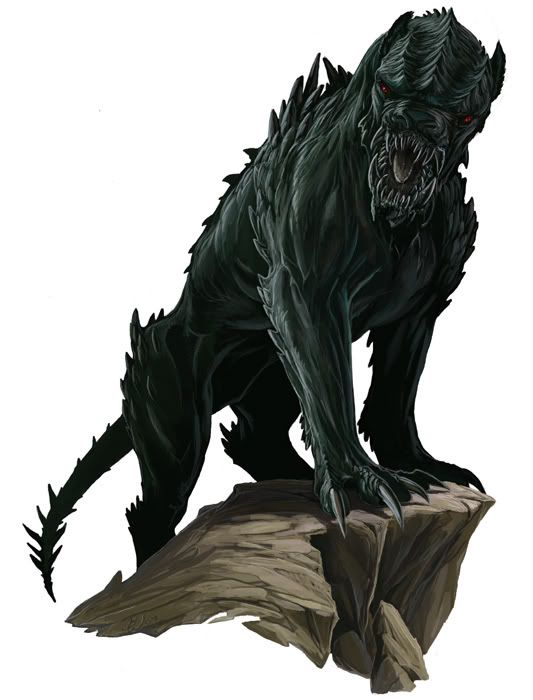The
Shadow Mastiff comes from the Feywild, but is not a Fey itself, being instead a Monstrosity. It’s a pretty cool opponent though, and surprisingly easy to work into your game, despite being a supernatural shadow dog.

I’m a really big fan of the artwork for this creature. It looks menacing and distinctly unfluffy, with a mouthful of fangs that only a mother could love. The artist also managed to make it look like it was breaking apart into wisps of shadow, which I think must have been a very difficult challenge. It’s cool.
The Shadow Mastiffs appear to be essentially just the dogs of the Shadowfell. Since that plane is a horrible wasteland full of undead, darkness, and Shadar-Ki, these puppies are pretty dangerous themselves. They seem to be a true-breeding race, and they come in packs, neither of which is likely to make your players any happier. They are often summoned by people who fancy the idea of sunlight-hating shadow dogs that can see into the Ethereal plane, in other words the kinds of people that your players are likely to want to rob, and can serve as excellent guard dogs. The entry name-checks the followers of Shar, Forgotten Realms goddess of shadow; they spend a lot of time fighting against the followers of Selune, goddess of the moon, and that is certainly a conflict that you can use to be the basis of a storyline. They can also just appear on the material plane - jumping through portals, either alone or as a pack - so can be good additions to any dark and haunted regions of your world.
The Shadow Mastiff can
not see invisible creatures, but does get advantage on hearing/smelling them; I’d have a think about how you want to rule that. In my game, being invisible simply lets you
try to stealth even while standing in the middle of the room, and does not usually give advantage unless I’m feeling generous (or it is a very noisy day, for example). I think that it is very easy for Rogues in particular to stealth, so they don’t need the help! Regardless, when running these guys as guard dogs, worth deciding that up front. In addition, they can see into the Ethereal plane - that undoes the benefit of
Etherealness, a level seven spell, and presumably some other tricks that I’m not aware of. It also means that Night Hags and Ghosts are both foiled by these guys, somewhat oddly. This seems to be less effective against player characters than it sounds, since using the ethereal plane is not normally how the heroes sneak around.
The Shadow Mastiff is similar to the Shadow, being much more potent in darkness than in light. It has
Sunlight Weakness for starters, and in addition half of its special abilities only work in dim light, such as its resistances to nonmagical weapons or its
Shadow Blend ability. This last one is the gem of this statblock: a bonus action to go invisible. Using this, a Shadow Mastiff can run up to a player, bite them, then turn invisible to give disadvantage to return attacks. However, they stop being invisible in ‘bright light’, so I would also expect at least one argument at the table about just how bright,
precisely, the party torch is. In practice, given how ubiquitous light sources are for player characters, this trick is not likely to work all that often; you might be able to do it by having the Shadow Mastiffs retreat and then go invisible, but they are not immune to opportunity attacks so that also might be a difficult one.
This entry gives you a pack of dangerous monsters who can be neutered somewhat by clever players. This means that they can vary wildly in difficulty, which is something that you could take advantage of - a combat in a room with lots of mirrors, for example, might be a memorable bout that lets the players feel like they did won by doing something other than just hitting things with swords. Like the Froghemoth, if you don’t want the fight to be that easily neutered, it’s worth combining them with something that can cast
Darkness, for example Hags. One last note is that they included a ready-made Alpha for the pack, which I thought was a clever touch - just a quick sidebar, rather than a whole statblock. These ones get slightly more HP, a higher intelligence, and gets a
Terrifying Howl that gives the Frightened condition out to 300 feet. That isn’t a hugely dangerous condition - especially if you rule that those who fail are only frightened of the Alpha, rather than all of the Mastiffs - but then this is only a CR 2 creature.
This is a solid entry. It will probably benefit from a custom-made location, as meeting one in a 10’x10’ brightly lit room will be pretty underwhelming for everyone. As an example, the Norse realm of Nidavellir, which Planescape located on the third layer of Ysgard, has the totally hilarious quality that no light source
of any kind functions there - it is Darkvision or Blindness, effectively, just as the native Dwarves and Gnomes like it. These guys would be an unholy terror under those conditions, so something similar might be a worthwhile inclusion. Regardless - this is a fun statblock, with a lot to distinguish them from just ‘bag of hitpoints shaped like a dog’.





